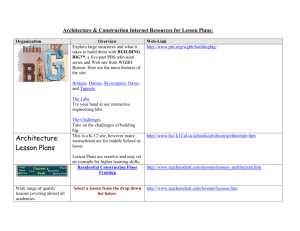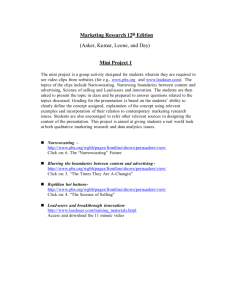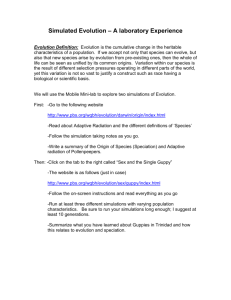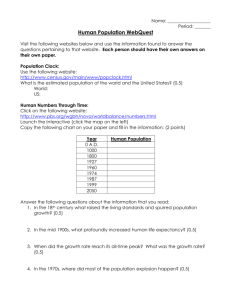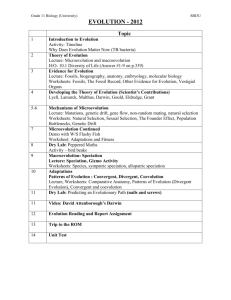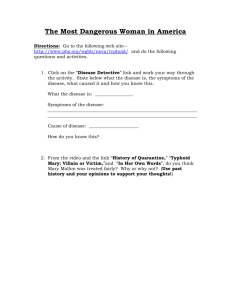Examining Natural Selection
advertisement
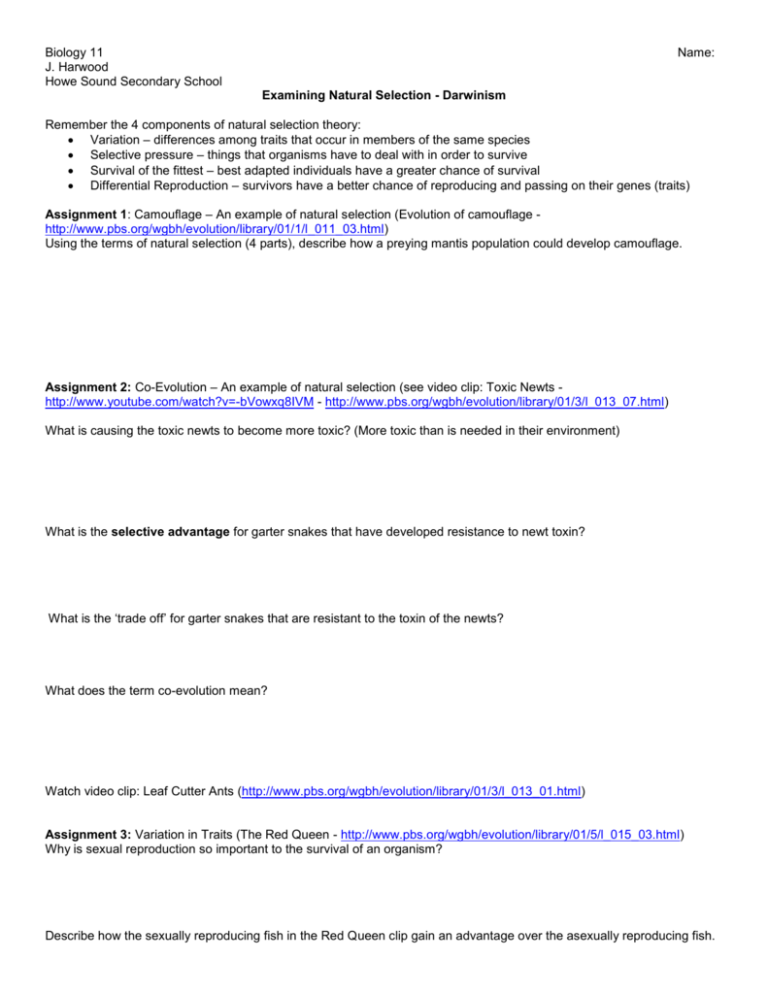
Biology 11 J. Harwood Howe Sound Secondary School Name: Examining Natural Selection - Darwinism Remember the 4 components of natural selection theory: Variation – differences among traits that occur in members of the same species Selective pressure – things that organisms have to deal with in order to survive Survival of the fittest – best adapted individuals have a greater chance of survival Differential Reproduction – survivors have a better chance of reproducing and passing on their genes (traits) Assignment 1: Camouflage – An example of natural selection (Evolution of camouflage http://www.pbs.org/wgbh/evolution/library/01/1/l_011_03.html) Using the terms of natural selection (4 parts), describe how a preying mantis population could develop camouflage. Assignment 2: Co-Evolution – An example of natural selection (see video clip: Toxic Newts http://www.youtube.com/watch?v=-bVowxq8IVM - http://www.pbs.org/wgbh/evolution/library/01/3/l_013_07.html) What is causing the toxic newts to become more toxic? (More toxic than is needed in their environment) What is the selective advantage for garter snakes that have developed resistance to newt toxin? What is the ‘trade off’ for garter snakes that are resistant to the toxin of the newts? What does the term co-evolution mean? Watch video clip: Leaf Cutter Ants (http://www.pbs.org/wgbh/evolution/library/01/3/l_013_01.html) Assignment 3: Variation in Traits (The Red Queen - http://www.pbs.org/wgbh/evolution/library/01/5/l_015_03.html) Why is sexual reproduction so important to the survival of an organism? Describe how the sexually reproducing fish in the Red Queen clip gain an advantage over the asexually reproducing fish. Asexual Reproduction Sexual Reproduction Disadvantages Advantages Assignment 4: Variation in Traits (see video clip: A Mutation Story – Sickle Cell Anemia http://www.pbs.org/wgbh/evolution/library/01/2/l_012_02.html) Mutations can be negative (negatively affect the chances for an organism to survive), neutral (no affect on organism) or positive. Describe how a mutation could have a positive effect on an organism. Hemoglobin is a protein found in your red blood cells. It holds oxygen in the red blood cells so that oxygen can be delivered to your tissues. Hemoglobin protein is made through protein synthesis. Each person has 2 hemoglobin genes that code for this protein and its amino acid sequence. A mutation in the gene alters the amino acid sequence and the function of the hemoglobin protein. 2 normal genes for hemoglobin 1 normal and 1 mutated gene for hemoglobin 2 mutated genes for hemoglobin (homozygous normal) (heterozygous) (homozygous abnormal) Advantage Disadvantage Assignment 5: Selective Pressures (one of the elements of Natural Selection) Define and give an example of each of the following. a. Selective pressure b. Abiotic selective pressures – Give examples, and explain in your own words c. Biotic selective pressures – Give examples, and explain in your own words Assignment 6: An adaptation is any characteristic or trait that increases an individual’s chances of survival. Types of Adaptations (Nelson Biology Text pg. 97) Give an example to show the difference in each of the following types of adaptations. a. structural adaptations b. physiological adaptations c. behavioral adaptations Assignment 7: Adaptations in predators and prey (video: Hunting and Escaping) Briefly describe and give an example of each of the following predator and prey strategies. Prey Defense Adaptations Predator Hunting Adaptations Groups or flocks Group Hunting Startle Display (warning) Nocturnal Hunting Poison Poison Warning Coloration Mimicry Mimicry Hiding (concealment) Decoys Altruism Social Hunting (altruism) Kin Selection Assignment 8: Types of Natural Selection 1. Directional Selection 2. Stabilizing Selection 3. Disruptive Selection Assignment 9: Sexual Selection – a type of natural selection (Video clip: Peacocks and Peahens http://www.pbs.org/wgbh/evolution/library/01/6/l_016_09.html) Natural selection usually works on a whole population of organisms. If it is advantageous for some members of a population to have especially good hearing (owls, for example), it is probably advantageous for everyone to have that trait. Why did Darwin have a problem with peacocks? Darwin saw that within a single species, there could be two strategies at work: For males it is: For females it is: What are female peacocks using in order to make their choice? What is sexual selection? Explain how the Peacock’s large and colourful train could be an example of stabilizing selection. Assignment 10: Sexual Selection in Humans (Video clip: Sweaty T-shirt Theory http://www.pbs.org/wgbh/evolution/library/01/6/l_016_08.html) Sometimes the “choice” may be unconscious as in the case of the “Sweaty T-shirt” study. Who was doing the choosing in this study? What were they basing their choice on? What is the selective advantage of this behavior or choice?
